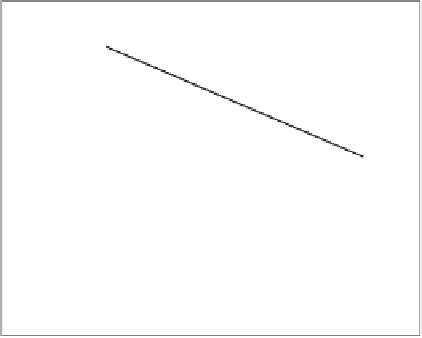Geography Reference
In-Depth Information
100.0
100.0
a)
b)
10.0
10.0
1.0
1.0
Mediterranean
Alpine-
Mediterranean
Alpine
Continental
Oceanic
gauging
post-event analysis
0.1
0.1
1
10
100
1000
10000
1
10
100
1000
10000
Area (km
2
)
Area (km
2
)
Figure 9.17. Specific maximum observed floods versus catchment area in central and southern Europe. Line shows the envelope curve of
Gaume et al.(
2009
). Floods stratified by (a) climatic regions and (b) measurement methods (for post-event analysis see Section 3.7.3). From
Marchi et al.(
2010
).
Probabilistic regional envelope curves have been tested in
Italy (see e.g., Castellarin et al.,
2007b
) and Germany
(Guse et al.,
2010
).
the result of altogether different processes than are
accounted for in the limited flood data. In other words,
process-based approaches are potentially more reliable for
describing more extreme floods. On the other hand,
process-based methods suffer from the fact that the par-
ameters of the rainfall
runoff model (or even the model
structure itself) need to be specified in ungauged catch-
ments. Usually, these parameters are estimated through
some kind of calibration in gauged catchments, and then
transferred or regionalised to the ungauged catchment in
question. Uncertainties are involved, especially if the
models are complex, with several parameters that need to
be specified (see
Chapter 10
). This problem is made worse
by the fact that the calibration must account for extreme
floods, not just ordinary floods, i.e., there must be confi-
dence that a flood of a specified return period predicted by
the model is consistent with what will be expected in the
ungauged catchment.
The classic example of process-based methods is the so-
called rational method (dating back to the 1850s, see Bedi-
ent and Huber,
1988
), which is widely used all around the
world. It belongs to the category of derived distribution
(event-based) approaches, and can be used to illustrate the
general principles and problems of process-based methods.
The input to the model is the so-called design storm, which
is derived from intensity
-
9.4 Process-based methods of predicting floods in
ungauged basins
An alternative to the statistical methods of regional flood
frequency that rely entirely on regional runoff or flood data
is to start with local or regional information on rainfall and
convert it to a flood using a rainfall
runoff model. Because
this approach uses rainfall, it can be deemed a process-
based method, and the transformation from rainfall to flood
peak may involve models ranging from very simple to very
complex.
There are advantages and disadvantages to process-
based methods over regional flood frequency methods.
First, in most countries, rainfall observation networks
are much denser and have been maintained for much
longer than stream gauging networks. Therefore, the
extremes of rainfall frequency distributions are likely to
be more accurately estimated than flood frequency
extremes. Process-based approaches exploit this advan-
tage. Second, process-based methods are designed to
mimic the most important rainfall
-
flood processes,
including local effects from, say, hydraulic structures. In
contrast, regional flood frequency analysis is only able to
transfer statistical information about annual maximum
flood peaks from similar catchments. This advantage from
process-based approaches becomes relevant if large return
periods are of interest, as the more extreme floods may be
-
runoff
-
frequency (IDF) curves
for the catchment or region of interest. The IDF curves
provide the annual maximum rainfall intensity of a specified
return period, and averaged over a specified duration. The
rational method then estimates the design flood by a decep-
tively simple formula (although in reality it is nowhere near
as simple as it appears), called the rational formula:
-
duration
-


















































































































































Search WWH ::

Custom Search